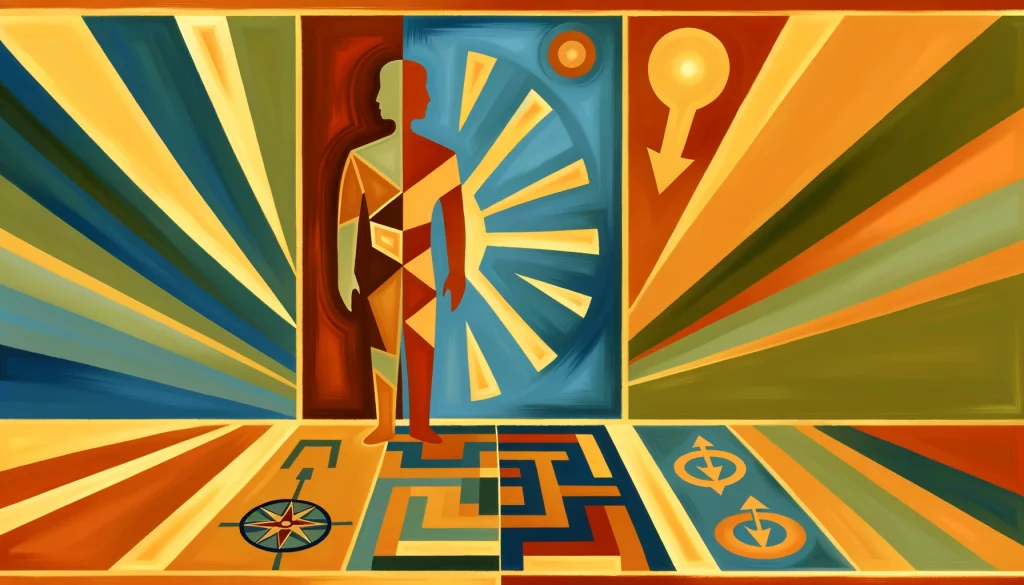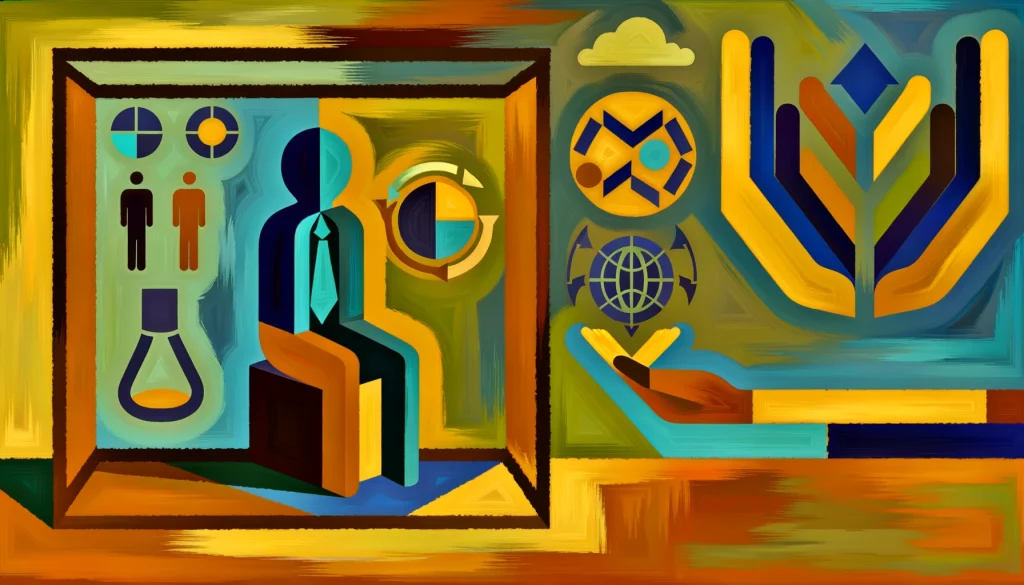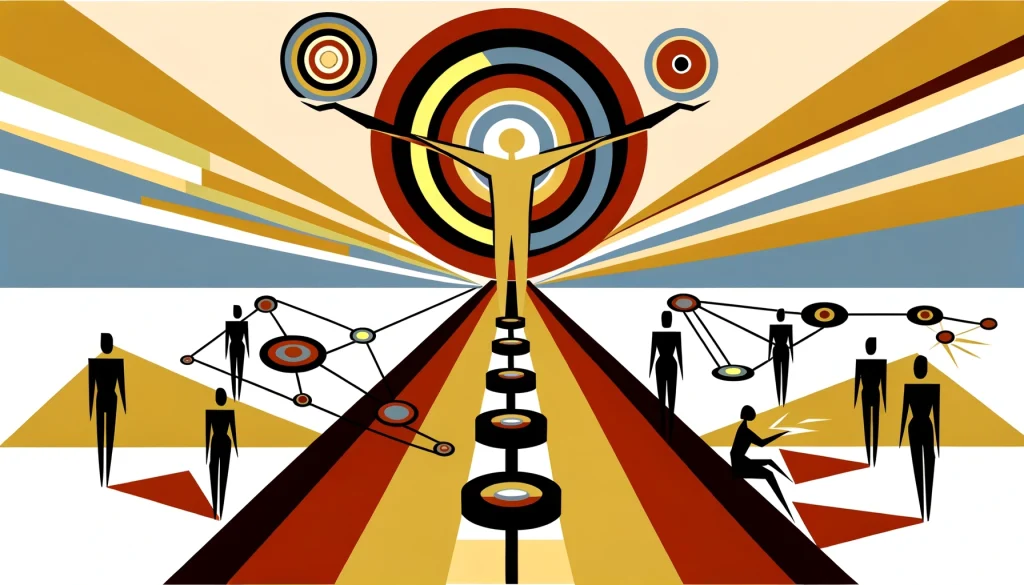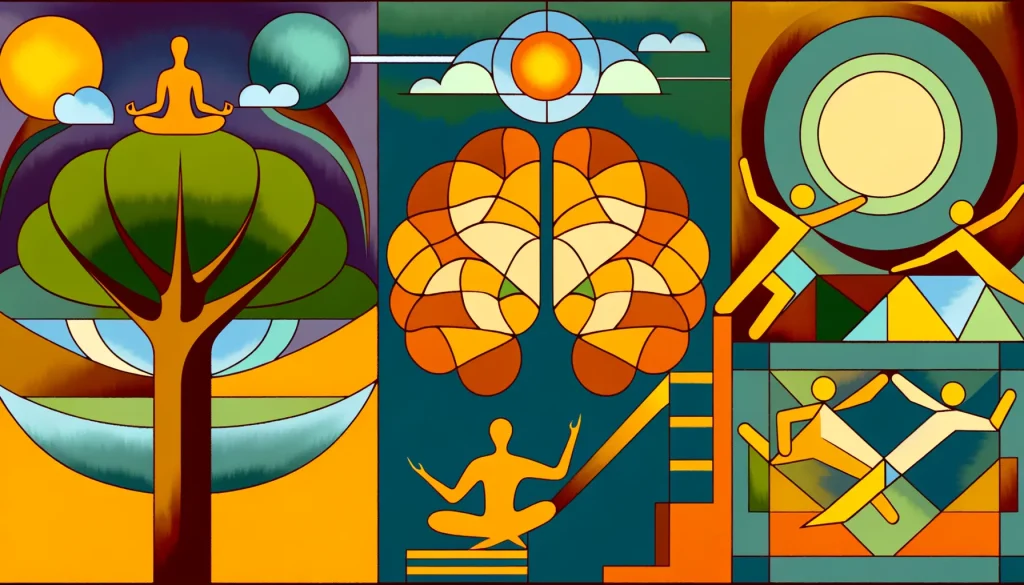Have you ever wondered why you click instantly with some people while others leave you feeling drained? Or why certain careers feel like a perfect fit while others make you want to run for the hills? The answer might lie in understanding your personality type! The 16 personalities framework, based on the Myers-Briggs Type Indicator (MBTI), has become one of the most popular tools for self-discovery worldwide. As someone who’s spent years studying personality psychology, I can tell you that knowing your type isn’t just fascinating – it’s transformative! According to recent studies, over 89% of Fortune 100 companies use personality assessments like the MBTI for team building and professional development. In this comprehensive guide, we’ll explore all 16 personality types, how they shape our lives, and most importantly, how this knowledge can help you thrive in 2025 and beyond!
The Origins and Evolution of the 16 Personalities Model
Let's talk about how the 16 personalities framework came to be—it's quite a fascinating journey! It all began with a mother-daughter duo, Katharine Cook Briggs and Isabel Briggs Myers, who were deeply curious about human behavior patterns.
"Isabel and her mother weren't actually trained psychologists," explains Dr. Maria Johnson, personality researcher at Stanford University. "They were incredibly observant women who noticed consistent patterns in how people behaved and made decisions. Katharine began her research in the 1920s by observing different types of people in her home."
When Isabel Briggs Myers joined her mother's work, they discovered Carl Jung's psychological theories about personality preferences, and something clicked. Jung had developed concepts about psychological functions like thinking, feeling, sensing, and intuition—and the Myers-Briggs duo saw practical applications for these ideas.
"What made their work revolutionary was how they systematized Jung's somewhat abstract theories into something applicable to everyday life," says personality historian Dr. Robert Chen. "They developed the first version of the Myers-Briggs Type Indicator during World War II, hoping to help women entering the workforce find jobs that matched their natural talents."
Over decades, the MBTI was refined through research and practical application. The assessment has evolved substantially from its original form to the versions we see today.
"There's often confusion between the official MBTI assessment and popular online versions like 16Personalities.com," notes certified MBTI practitioner Sandra Williams. "The official assessment is rigorously developed and owned by The Myers & Briggs Foundation, while 16Personalities adapts the framework and adds elements from the Big Five personality model."
The scientific community has had mixed responses to the MBTI framework. Many research psychologists prefer the empirically-validated Big Five model, but practitioners often find the MBTI more useful for personal development.
- The MBTI was developed by two women without formal psychology training but with keen observational skills
- The framework is based on Carl Jung's theories about psychological preferences
- The assessment has evolved significantly since its creation in the 1940s
- Scientific criticism focuses on issues with reliability and measuring continuous traits with binary categories
- Modern versions like 16Personalities.com blend the traditional MBTI with other personality frameworks
Breaking Down the Four Dichotomies
The 16 personalities model is built on four key dichotomies—think of them as preference pairs or different ways of operating in the world. Let's unpack each one!
"The first dichotomy, Extraversion versus Introversion, is probably the most widely understood," says cognitive psychologist Dr. James Liu. "But there are still misconceptions. It's not about being outgoing versus shy—it's about where you get your energy. Extraverts are energized by the external world of people and activity, while introverts recharge through solitude and internal reflection."
When we move to the second dichotomy, Sensing versus Intuition, we're looking at how people gather information.
"Sensors focus on concrete, tangible details and practical realities—what they can directly observe," explains career counselor Diane Rodriguez. "Intuitives are more attuned to patterns, possibilities, and the bigger picture. If you're describing a forest, a Sensor might tell you about the types of trees and the condition of the soil, while an Intuitive might talk about the ecosystem's harmony or the forest's potential future."
The third dichotomy, Thinking versus Feeling, addresses how people make decisions.
"This isn't about intelligence versus emotion," clarifies organizational psychologist Marcus Williams. "Thinkers prioritize objective criteria and logical consequences when making choices. Feelers consider values and how decisions will impact people. A Thinking-oriented manager might restructure a department based purely on efficiency, while a Feeling-oriented one might prioritize team morale and individual strengths."
The final pair, Judging versus Perceiving, reveals how people organize their external world.
"Judging types prefer structure, closure, and definitive plans," says lifestyle coach Rebecca Chen. "They feel satisfied when decisions are made and things are settled. Perceiving types prefer flexibility, openness to new information, and spontaneity. They feel restricted by too much structure and prefer to keep their options open."
These four dimensions combine to create the 16 distinct personality types, with each person having preferences in all four categories.
- Extraversion (E) vs. Introversion (I) determines whether you gain energy from external interaction or internal reflection
- Sensing (S) vs. Intuition (N) reflects whether you focus more on concrete facts or patterns and possibilities
- Thinking (T) vs. Feeling (F) indicates whether you prioritize logical consistency or values-based harmony in decisions
- Judging (J) vs. Perceiving (P) shows whether you prefer structure and closure or flexibility and openness
- Your four-letter type (like INFJ or ESTP) represents your preferences in all four dimensions
Exploring the 16 Personality Types in Detail
When we combine the four dichotomies we just discussed, we get 16 unique personality types that fall into four temperament groups. Let's explore these groups and the types within them.
"The four temperament groups help us understand the broader patterns among the 16 types," explains typology expert Dr. Sarah Mendez. "Analysts (NT types) are driven by competence and knowledge. Diplomats (NF types) focus on authenticity and meaningful connections. Sentinels (SJ types) value tradition and responsibility. Explorers (SP types) prioritize freedom and practical skill."
Let's look at the Analysts first. This group includes INTJ, INTP, ENTJ, and ENTP—all strategic, knowledge-seeking types.
"INTJs, often called the 'Architects,' are independent strategic thinkers with a talent for system building," says corporate consultant Michael Lee. "They're often misunderstood as cold or aloof, but they simply prioritize competence and logical solutions. Famous INTJs might include Elon Musk and Michelle Obama—visionaries who implement their ideas methodically."
The Diplomats group (INFJ, INFP, ENFJ, ENFP) focuses on human potential and connection.
"ENFPs, the 'Campaigners,' are enthusiastic, creative people who see possibilities in everything and everyone," notes relationship therapist Julia Winters. "They're incredibly perceptive about others' motivations and needs. A common misconception is that they're flighty or unfocused, when actually they're deeply committed to their core values. Think Robin Williams or Jennifer Lawrence—charismatic individuals who connect authentically with others."
Sentinels (ISTJ, ISFJ, ESTJ, ESFJ) are the practical guardians of tradition and social institutions.
"ISTJs, known as 'Logisticians,' are responsible, detail-oriented individuals who value reliability and practical solutions," explains organizational psychologist Thomas Chang. "They excel at creating and maintaining systems that work efficiently. A misconception is that they resist all change, when they simply want to ensure changes are practical and necessary. Warren Buffett and Queen Elizabeth II exemplify the steady, responsible ISTJ approach."
The Explorers group (ISTP, ISFP, ESTP, ESFP) includes flexible, in-the-moment types who excel at tactical problem-solving.
"ESTPs, the 'Entrepreneurs,' are energetic, practical problem-solvers who thrive in dynamic situations," says sports psychologist Maria Gonzalez. "They have an incredible ability to read a room and adapt to changing circumstances. They're sometimes stereotyped as reckless thrill-seekers, but they're actually skilled tacticians who understand risks. Famous ESTPs might include Donald Trump and Madonna—bold individuals who seize opportunities as they arise."
- The 16 types are organized into four temperament groups: Analysts (NT), Diplomats (NF), Sentinels (SJ), and Explorers (SP)
- Each type has characteristic strengths (like INTJs' strategic thinking or ENFPs' people skills) and challenges (like INTJs' potential aloofness or ENFPs' difficulty with routine)
- Type descriptions should be viewed as patterns rather than rigid boxes—individual variation exists within each type
- Famous examples help illustrate type patterns but remember that public personas may not reflect true type
- Identifying your own type requires honest reflection on your natural preferences, not who you aspire to be
How Your Personality Type Shapes Your Career Path
Your personality type can offer fascinating insights into your career journey—from the environments where you'll likely thrive to how you handle workplace challenges.
"Different personality types are naturally drawn to different kinds of work," explains career development specialist Dr. Jason Park. "For instance, INTJ and ENTJ types often excel in strategic leadership roles, systems analysis, or scientific research due to their logical approach and long-term vision. Meanwhile, ESFJ and ENFJ types typically thrive in human-centered roles like teaching, healthcare, or human resources where they can directly support others' wellbeing."
The way you process information and make decisions significantly impacts your ideal work environment.
"Intuitive types often prefer jobs that involve innovation, theory, and future possibilities," notes workplace consultant Rebecca Lee. "They might feel stifled in highly routine positions. Sensing types typically excel in roles requiring attention to detail, practical application, and present-focused problem-solving. I've seen many Sensors become frustrated in jobs that seem too abstract or constantly changing without clear purpose."
Understanding your type can be particularly valuable during job interviews and career transitions.
"When I work with clients on interview preparation, we focus on authentically showcasing their natural strengths based on type preferences," shares executive coach Martin Simmons. "For example, I might help an ISTP highlight their troubleshooting abilities and hands-on problem-solving rather than trying to project the visionary leadership style that might come naturally to an ENFJ. Authenticity in knowing your strengths is far more effective than trying to be something you're not."
Team dynamics are also heavily influenced by personality type diversity.
"The most effective teams I've consulted with have complementary personality types," observes organizational psychologist Dr. Leila Johnson. "For instance, pairing detail-oriented ISTJs with big-picture ENTPs can create a balance where both strategic vision and practical implementation are covered. The key is recognizing these differences as strengths rather than sources of conflict."
- Each personality type brings distinct strengths to the workplace (like INTPs' analytical abilities or ESFJs' team-building skills)
- Industries where specific types flourish include technology and science for NT types, helping professions for NF types, administration and logistics for SJ types, and action-oriented fields for SP types
- Understanding your type helps identify potential workplace stressors and how to manage them effectively
- Personality insights can guide authentic self-presentation during job interviews and career advancement
- Diverse teams benefit from different personality perspectives when differences are respected and leveraged intentionally
Relationships Through the Lens of 16 Personalities
Relationships take on fascinating dimensions when viewed through the lens of personality type. Whether romantic partnerships, friendships, or family connections, understanding type differences can transform how we relate to one another.
"One of the most powerful aspects of the 16 personalities framework is how it helps us understand that different people have fundamentally different needs and communication styles," explains relationship therapist Dr. Elena Martinez. "For example, an INFJ partner might need deep, meaningful conversations and plenty of alone time to process emotions, while an ESTP partner might prefer active, shared experiences and straightforward communication."
Compatibility between types isn't as simple as matching identical or completely opposite types. It's more about understanding and appreciating differences.
"I often see successful relationships between types that share some preferences but differ in others," notes couples counselor James Thompson. "For instance, an ENFP and INFJ might connect through their shared intuitive and feeling preferences while balancing each other with their different approaches to social energy. The key is whether partners can respect and learn from their differences rather than trying to change each other."
Communication styles vary dramatically across the 16 types, creating both connection opportunities and potential friction points.
"Thinking types tend to communicate directly and focus on solving problems, while Feeling types often prioritize emotional validation before moving to solutions," observes family therapist Sarah Johnson. "This difference can lead to conflicts when a TJ type jumps straight to fixing an issue that an FP type just wanted emotional support around. Learning to adapt your communication style based on your partner's needs is a tremendous relationship skill."
Parenting approaches are also heavily influenced by personality type.
"Different parent-child type combinations create unique dynamics," explains child development specialist Dr. Robert Chen. "An ISTJ parent might provide wonderful structure and stability for children but might need to consciously work on emotional expressiveness. An ENFP parent might create an environment rich in creativity and warmth but might need to be intentional about consistency and practical details."
- Compatibility depends more on mutual understanding and respect than on specific type matches
- Communication challenges often stem from different information-gathering and decision-making preferences (S vs N and T vs F)
- Conflict resolution is enhanced when each partner recognizes how type differences affect perspectives
- Parenting styles reflect personality preferences, with some types emphasizing structure and others emphasizing exploration
- Friendship patterns often reflect type preferences, with introvert-introvert friendships featuring depth and extravert-extravert connections featuring breadth of experience
Personal Growth and Development for Each Type
Personal growth looks different for each of the 16 personality types, with unique blind spots and development opportunities. Understanding your type can provide a roadmap for meaningful self-improvement.
"Each type has characteristic 'shadow areas'—parts of personality that are less developed or conscious," explains personal development coach Dr. Michelle Lang. "For instance, INTPs typically have highly developed logical analysis but might struggle with emotional awareness and expression. Their growth path often involves developing their inferior function—Extraverted Feeling—to better connect with others' emotional needs and express their own feelings."
Each type responds to stress in characteristic ways that can provide clues for personal development.
"Under stress, people often display exaggerated or unhealthy expressions of their preferences," notes psychotherapist David Chen. "An ESTJ who is typically organized and decisive might become rigidly controlling under pressure. An INFP who is normally compassionate and authentic might withdraw completely or become hypersensitive when overwhelmed. Recognizing these patterns is the first step toward developing healthier responses."
Personality-based development isn't about changing your type but about becoming a more balanced version of yourself.
"The goal isn't to become a different type—that's neither possible nor desirable," emphasizes holistic wellness coach Sophia Rodriguez. "Instead, it's about developing your less preferred functions in service of your authentic self. An ENFJ doesn't need to become an ISTP, but they might benefit from developing some of the practical analysis and autonomy that comes naturally to ISTPs."
Different types benefit from tailored self-improvement approaches.
"I've found that Thinking types often respond well to logical frameworks for personal growth with clear metrics," shares executive coach Marcus Williams. "Feeling types frequently connect better with growth approaches that align with their values and incorporate emotional reflection. Recognizing these preferences helps people choose development tools that resonate with them."
- Each type has characteristic blind spots (like ENTJs' potential insensitivity to emotions or ISFPs' possible resistance to long-term planning)
- Development often involves strengthening your less dominant functions for greater psychological balance
- Stress responses provide clues to personal growth needs (such as an INFJ becoming critical under stress, indicating a need to develop healthier self-care)
- Different types benefit from different growth strategies—some respond to structured approaches, others to creative exploration
- Personal development isn't about changing your fundamental preferences but becoming a more balanced version of yourself
The Science Behind Personality Testing
Let's explore what science tells us about personality and how the 16 personalities model fits into the broader landscape of personality psychology.
"Current research in personality psychology predominantly centers around the Big Five or Five-Factor Model," explains research psychologist Dr. Jennifer Harris. "This model—measuring Openness, Conscientiousness, Extraversion, Agreeableness, and Neuroticism—has extensive empirical support. The 16 personalities framework shares some conceptual overlap, particularly between Extraversion dimensions, but organizes traits differently."
The reliability and validity of personality assessments vary widely and are central to scientific discussions.
"From a psychometric perspective, we evaluate assessments on their reliability—do you get consistent results when taking it multiple times—and validity—does it actually measure what it claims to measure," notes psychometrics expert Dr. Michael Chen. "The original MBTI has shown moderate reliability, with the highest consistency for the E-I dimension and more variability for J-P. Newer models like 16Personalities.com have incorporated elements of the more empirically-validated Big Five, potentially improving validity."
Brain science is shedding new light on personality differences.
"Neuroimaging studies suggest biological correlates for some personality dimensions," shares neuroscientist Dr. Laura Patel. "For instance, extraversion has been linked to differences in brain reward systems and response to stimulation. There's also evidence that thinking and feeling preferences might relate to different neural pathways for decision-making. However, it's important to note that the brain is incredibly plastic and can develop new pathways throughout life."
Personality stability and change over the lifespan is another fascinating area of research.
"Longitudinal studies show that core personality traits tend to be relatively stable in adulthood, but with gradual changes over decades," explains developmental psychologist Dr. Robert Singh. "Most people become somewhat more conscientious and emotionally stable as they age. However, significant life events or intent
Conclusion
Understanding the 16 personalities isn't about putting yourself in a box—it's about opening doors to greater self-awareness and compassion for others! By recognizing your natural preferences and tendencies, you can make more informed choices about your career, relationships, and personal growth journey. Remember, no personality type is better than another, and each has unique gifts to offer the world. The real power comes from using these insights as a starting point for deeper self-exploration and understanding. Whether you're an analytical INTJ, a compassionate ENFJ, or any type in between, embracing your authentic self while appreciating others' differences creates a foundation for more meaningful connections and fulfilling experiences. Ready to put this knowledge into action? Take a reliable personality assessment, reflect on the results with an open mind, and start applying these insights to the areas of your life where they matter most!






